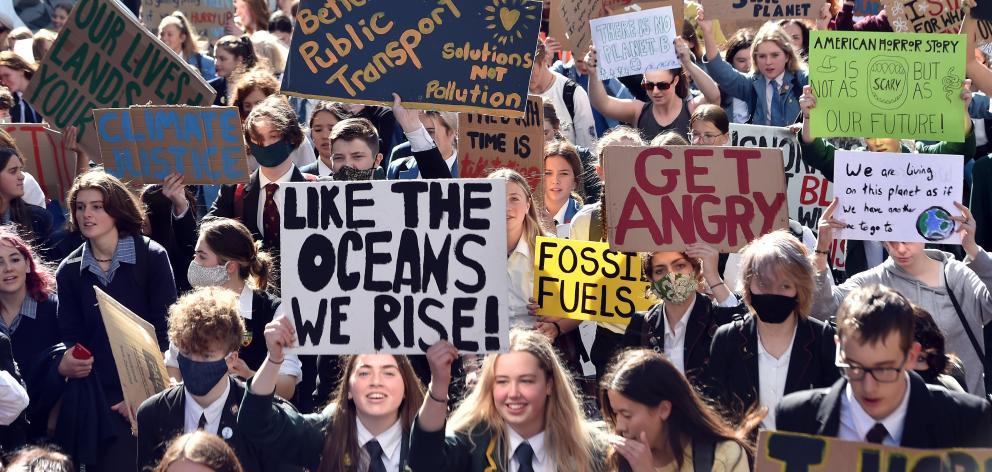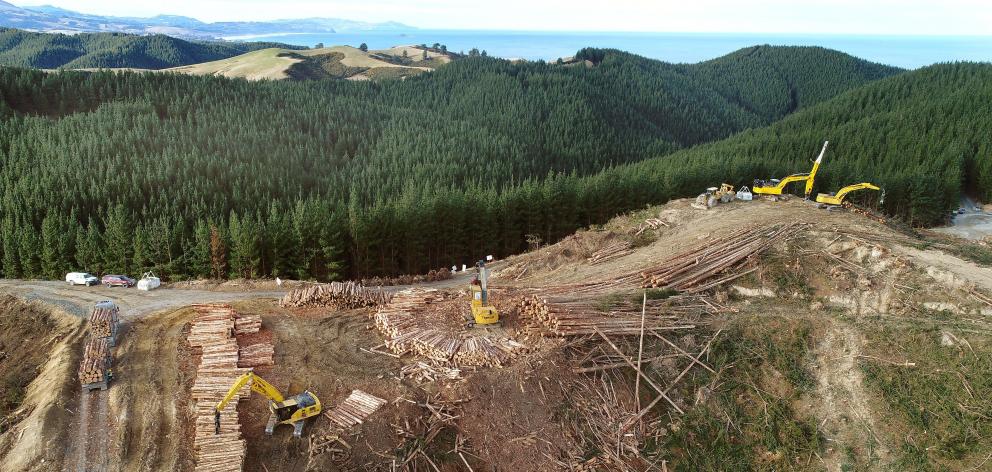We now have a plan of action to guide our climate change response. But is it any good? Members of the University of Otago’s He Kaupapa Hononga climate change research network run the ruler over it.
 ON THE PATH
ON THE PATH

This week we saw Aotearoa’s first Emissions Reduction Plan (ERP), and Climate Emergency Response Fund, released ahead of Thursday’s Budget. These actions follow on from national commitments made in Paris in 2015 — to reduce our emissions in line with a path to keep global warming to at most 2degC and preferably 1.5degC above pre-industrial temperatures — and in Wellington in 2019 when Parliament approved the Climate Change Response (Zero Carbon) Amendment Act with cross-party support. Do these actions we are taking in 2022 fulfil the commitments we made in 2015 and 2019? They do not, but they are at least first steps on the path to keeping our national commitment to fair and effective climate action.
At the most basic level, the carbon budgets approved this year will not meet our Paris commitments. By 2030 they will be at least 20 megatonnes (Mt) short, and those shortfalls will presumably be made up with purchases of overseas carbon credits. Fundamentally, the carbon credit market exists to allow polluters to emit more than their fair share while postponing domestic investment in the transition to a low-emissions economy. While we are paying others to take climate action, we are only making our eventual shift to a cleaner, healthier system more difficult by artificially extending the lifespan of practices no longer fit for purpose in a warming world.
We might call these practices "zombie" systems because even though they are still moving around they are already effectively dead. We rely on under-insulated buildings for housing, dirty and dangerous personal cars for transport, a fragile hydropower-based system already at risk from climate change for energy, and an extractive economy that exports our natural capital for foreign exchange. Each of these systems imposes massive costs on us already, even apart from their disproportionate contribution to global climate change. It is high time for transition to something better.
We are at least now on that path.
Prof Lisa Ellis is director, Philosophy, Politics, and Economics Programme at the University of Otago.
 TRANSPORT
TRANSPORT

Transport accounted for 39% of New Zealand’s CO2 emissions in 2019, and 17% of gross emissions across all greenhouse gases. Faced with those large percentages, it makes sense that the ERP emphasises decarbonising transport, in particular land transport. As well as emissions from land transport, New Zealand’s transport emissions total includes emissions from flights within New Zealand and coastal shipping, such as the interisland ferries. However, greenhouse gas emissions from international aviation and international maritime transport are not part of any country’s National Greenhouse Gas Inventory total, including ours. As a result, zero percent of the first emissions budget mentioned in the ERP is allocated to international planes and ships bringing people and goods to New Zealand.
The ERP lists an action to "Work to decarbonise aviation" and another to "Progress the decarbonisation of maritime transport". Some of the specific initiatives within those actions are for domestic aviation and maritime transport, whereas some of them might apply to international transport. Unfortunately, most of the specific initiatives are vague, using phrases such as "develop and set targets", "establish a public-private leadership body", and "develop a national action plan". One initiative stands out for its firmer wording: "Implement a sustainable aviation fuel mandate".
"Sustainable aviation fuel" is one of those "magic bullet" ideas that has been rolled out for many years, offering the elusive promise that business-as-usual and endless aviation growth can continue because some time "soon" aviation will be sustainable. Way back in 2008, I gave an invited talk at a symposium titled "Sustainable Aviation", run by the Royal Aeronautical Society New Zealand Division. I was asked to give the first talk about "What’s the problem?" and my talk was entitled "Can aviation be sustainable? The impacts of air transport on climate". I laid out the impacts on Earth’s climate of planes burning fossil fuels, and presented results from research on how off-setting would be extremely challenging in terms of land needed given the huge level of aviation emissions associated with travel to and from New Zealand.
The later talks included ones on current and future technologies. This was the era when "sustainable aviation fuels" meant "jatropha", a tree that nuts were to be harvested from and mixed half-and-half with Jet A-1 fuel. In 2009, Air New Zealand was reported as saying that by 2013 they "expected biofuel to make up about 10% of its total fuel burn". That did not happen, and it is still not possible to buy sustainable aviation fuel in New Zealand. The "magic bullets" in the ERP are "biofuels" and "hydrogen", and it appears that the Government is prepared to throw money into work on these. What is missing from the ERP is a solution that is guaranteed to actually reduce emissions from aviation: restricting the number of flights.
Dr Inga Smith is co-director of He Kaupapa Hononga: Otago’s Climate Change Research Network and is based in the Department of Physics at the University of Otago.
 DEMOCRACY
DEMOCRACY

If we are to get to net zero by 2050, this first ERP is just the first step. The next 25 years will require even more fundamental changes. Changes to everything that we do, in all aspects of our lives, in all sectors.
What strikes me hard is the realisation that, despite its apparent comprehensiveness, this is the easy stuff, the simple wins. The next ERP, and the ones after, will need to support even more radical changes to the everyday lives of families and businesses.
This means that we can’t forever expect to replace like with a slightly greener like, such as our petrol cars with EVs. We will need to adjust our expectations about what is normal, and learn to live with less. We will acquire new routines, alter the stuff we have in our lives, and stop expecting to fly internationally every year or two. We will need to develop a sense of the carbon flows in our lives, in much the same way that we currently have a feel for money flows.
And at the same time we are making these mental and physical changes, we will also be needing to adapt to the impacts of climate change, which means even more adjustments.
So although the ERP might look radical to some, it is nothing compared to how radical future plans will need to be.
If people (in the many roles they play in life) are not ready for these changes, or feel challenged or disempowered by them, our nation will face grave risks. Risks of misinformation campaigns, societal fractures, political backsliding, or even our own version of the gilets jaunes movement in France, which was sparked by poorly designed carbon policy.
So it is critical at this early stage to engage people in what this transition will mean and support those who are already at the forefront of change. People need to be engaged not just as individuals and consumers, but in their shared lives as whanau/families, workers, sports enthusiasts, church goers, students, kainga/community members, iwi/hapu.
The ERP has taken some initial steps in this direction with its promise to support Maori-led strategies and to support regions and communities to help them plan for the transition. But much more could be done. Citizens assemblies are one example: involving a group of ordinary Kiwis in learning, discussing and proposing policies and other actions. This "deliberative democracy" approach has already been used in many nations to design people-centric policies for climate action.
If this long journey of transition is not "owned" by the people of Aotearoa, then we will falter and fail.
Prof Janet Stephenson is deputy director of the Centre for Sustainability at the University of Otago.
 OCEANS
OCEANS

It is great to see that the potential of marine ecosystems to remove carbon dioxide from the atmosphere and store it (blue carbon) is recognised in the ERP, next to on-land carbon storages such as forestry. The term blue carbon describes carbon sequestered in the open ocean and coastal habitats, including in kelp forests, salt marshes, wetlands, and mangroves. Research shows the enormous potential of blue carbon as a natural solution for carbon storage and the ERP mentions several projects in Aotearoa in this area, such as the "Core and Restore" project in Te Tauihu and the Endeavour-funded project on carbon sequestration in southern fiords. This project builds on work led by Assoc Prof Candida Savage in the marine science department at Otago that showed fiords represent carbon sink "hotspots" and bury more organic carbon per unit area than other marine areas, playing a crucial role in regulating climate change. Using a multi-disciplinary team of scientists, the new project will focus on how altered circulation patterns, driven by changing climate and changes in freshwater discharge associated with power generation, will impact carbon stocks and sequestration in fiord sediments given forecast climate change scenarios.
While research like this is absolutely essential to better quantify existing blue carbon stocks and understand the potential threat they are under, scientific projects take time, and we need to act now.
What we do know for sure is that degraded ecosystems cannot store carbon efficiently and over long periods of time. Any form of degradation of coastal ecosystems through either climate change-related stressors, such as heatwaves, or ocean acidification or, for example, sediment load and other forms of pollution, is a threat to biodiversity and ecosystem functioning and it is essential that we enforce strict protection of existing coastal ecosystems and active restoration of degraded ones.
While the ERP mentions "restoring wetlands and coastal ecosystems (e.g., peatlands, salt marshes and mangrove swamps) to sequester carbon and provide natural defences against flooding, drought and sea-level rise, while supporting abundant biodiversity", we would need to increase our activity in this area exponentially to make any significant impact in the near future. Therefore, we need to rapidly adapt a holistic mindset when it comes to emissions reduction and carbon storage. Any land-based activities need to be assessed in terms of potential negative impacts on the marine ecosystem.
Assoc Prof Linn Hoffmann is director of the Future Ocean Research Theme at the University of Otago.
 FORESTRY
FORESTRY

The Climate Change Commission’s recommendations to Government made it clear that tree planting for carbon sequestration cannot substitute for meaningful reduction in emissions. This clear and commendable thinking is reflected in the four areas of focus for forestry in the ERP.
The first focal area is supporting afforestation in the right locations with the right species. In line with proposed changes to the ETS permanent forest category, the ERP aims for a more informed and restricted use of exotic trees for carbon sequestration while protecting productive land uses. It also signals support for new types of forest crops and for a better approach to forestry on remote or erosion-prone land.
The second focus is on encouraging native afforestation by improving incentives and reducing the cost of establishing natives. While native trees are slower to establish, and therefore absorb carbon more slowly than exotic species such as radiata pine, our long-lived forest giants, as well as alternative exotic species such as Californian Redwood, continue to absorb carbon for centuries. This is an important consideration in planning a sustainable low-emissions future. While fast growing exotics such as radiata pine absorb significant amounts of carbon in the first 20 years after establishment, thus making the nation’s net emissions bottom line look good, they also reach maturity much sooner and once a forest is mature it can no longer earn carbon credits under the ETS. It also cannot be harvested without a significant financial penalty. By emphasising native afforestation the ERP is aiming to stimulate a forestry model that will provide carbon credit income for generations to come as well as provide for other sustainable income streams such as specialty bush foods, rongoa and honey.
The third focus of the ERP is the significant carbon stores in forests that existed prior to 1990, when the Kyoto agreement came into effect, but which are currently excluded from the ETS. Management practices such as stock exclusion and pest control that protect and increase these existing carbon stores could be incentivised by including existing forests in the ETS. More of these forests could also be used for sustainable continuous cover forestry (CCF), providing an incentive for their protection. CCF is common internationally and involves selective harvest while maintaining the forest canopy and habitat. Logging costs would be higher so this option may only be feasible for high value timber species, again emphasising the need to consider the right mix of tree species.
Growing the forestry and wood-processing industries is the fourth focus of the forestry section of the ERP. The signalled investment in low-emissions wood products is welcome, as the current situation where whole logs are exported and processed timber products are imported carries with it a high carbon footprint as well as low resilience, as shown in recent months with a shortage of building supplies. The inclusion of support for woody biomass to replace coal was less convincing. Certainly, the energy and transport sectors need to end their reliance on fossil fuels but burning recently sequestered carbon is little better than burning 300million-year-old carbon. Still, it is a step in the right direction and would hopefully result in less forestry waste in waterways. Overall, the plan for forestry in the ERP reflects sensible long-term thinking that also provides for alternative income streams so is a welcome contribution to the first emissions budget.
Assoc Prof Janice Lord is an associate professor in the University of Otago, Botany Department.
 AGRICULTURE
AGRICULTURE

For agriculture, the Government’s ERP encourages uptake of technology, innovation, matauranga and te ao Maori without excessively adding more restriction on farming activities. Capping nitrogen fertiliser to less than 190kg per hectare per year will encourage the use of fertilisers that reduce emissions, such as urease and nitrification inhibitors, and slow-release products. Not adopting a blanket ban on synthetic nitrogen recognises agriculture requires nitrogen (synthetic or otherwise) to grow plants, combining a cap with technologies that more precisely delivery sufficient nitrogen to plants will lead to improved efficiency.
How exactly the plan emphasises nature-based (such as regenerative) solutions and the use of matauranga Maori will need significant consultation and supporting evidence. Matauranga is presented as if there are solutions on the shelf ready for development. While conventional technologies such as nitrification inhibitors and methane vaccines are presented as tools that might become available for reducing emissions, details are vague when it comes to how specific matauranga examples will be developed. Without rangahau (research) support it will be difficult to translate matauranga into emissions reduction tools for all agriculture.
It is particularly encouraging to see the establishment of a new Centre for Climate Action on Agricultural Emissions. How the centre will drive emissions reduction technologies via a step change in research, development, and commercialisation will be challenging. If it is to faster develop, commercialise, and enable uptake of emissions mitigation technologies, those responsible for the new centre will need to understand science-led industry adoption of new and innovative technologies. It will be interesting to see who an enhanced New Zealand Agricultural Greenhouse Gas Research Centre will partner with in the private sector for this new joint venture.
The introduction of emissions pricing for agriculture from 2025 could encourage early adoption of on-farm changes to reduce emissions. However, the support for those early adopters will need to be considerable and what the Government is considering should be introduced sooner rather than as an afterthought. Acceleration of adoption and on-farm trials of overseas technologies to adapt them for the Aotearoa pastoral farming context should be approached with caution as research how best to do this will need to be directly transferable to or independently conducted here to validate these technologies.
Prof Craig Bunt (Te Atiawa, Ngati Toa, Ngati Mutunga), is director of the Agricultural Innovation Programme, University of Otago.
 BUSINESS
BUSINESS

Prof Kevin Anderson in his talk last year at the He Kaupapa Hononga symposium asked the question — "Controlled radical change or uncontrolled chaotic change — which would you prefer?". Te hau marohi ki anamata, the first Emissions Reduction Plan for Aotearoa is a step for Aotearoa New Zealand to develop a more controlled response to climate change.
Climate change is a systemic issue and this report covers a number of key sectors in the environment for initial change. While the document is vague in places and seems to lack some detail, it is an initial document that is setting the scene across the economy for a transition to a low carbon future.
For business the key question is going to be, very simply, what is the low emission option? For all activities, products and services this question will need to be asked. This question will become increasingly important for anything that uses energy in any form. For energy in the form of liquid fossil fuels for cars or solid boilers for heat there will be funding available to help switch to renewable options. Electrification is encouraged and industry is also being directed to use energy efficiently.
In places the report also hints at businesses completing a carbon footprint and being able to show reductions to that footprint. It also suggests that carbon disclosures need to go beyond publicly listed companies. It is saying that understanding and reducing emissions will become commonplace, as will understanding climate risks and mitigating for the physical impacts of climate change.
The report discusses strategies around a just and sustainable transition. In Aotearoa New Zealand 97% of businesses are small. Businesses employing fewer than 20 people account for 28% of employment. MBIE’s small business strategy includes needing to understand the needs of small business, enabling easier access to finance, helping build capability and skills and designing an enabling environment. A just transition in Aotearoa means across communities, iwi, people, place but also across business and especially our small businesses.
If we are to have a just and sustainable transition then the key is to follow the small business strategy and work with small businesses to understand their needs and support them through finance, skills, knowledge and regulation. Small businesses are a significant feature of the business environment in Aotearoa and will play an important role in the low emissions transition, but are often left out of the discussion.
We need to ensure that a just transition includes 97% of businesses and not just the 3%. As such, we need all business support networks to be engaging and supporting their members to get ready for this transition and helping see opportunities and ways forward. There is no going back. Importantly at this moment in time, we have the opportunity for controlled radical change. Let’s not lose this opportunity. Consequently, my suggestion is for us to all move with the strong winds into the future — te hau marohi ki anamata!
Assoc Prof Sara Walton is co-director of He Kaupapa Hononga: Otago’s Climate Change Research Network and is based in the Department of Management at the University of Otago.
The writers are all University of Otago academics who are members of the He Kaupapa Hononga: Otago’s Climate Change Research Network.
He Kaupapa Hononga recently launched their "Come join us" campaign, encouraging people to sign up to their email list. See their video here: https://tinyurl.com/2r279nkc
Comments
Why is there no mention of the technology developed and being developed that removes carbon from the atmosphere? Locking down might work for a Virus but that doesn't translate across as a solution for climate change. Humans didn't stop using steam engines because coal ran out....some one used their intelligence and invented something better. The current ideas are all past focused solutions based on lock down mentality when better solutions will only be found in the future.
The future is pie in the sky, everyone's getting on board now.











